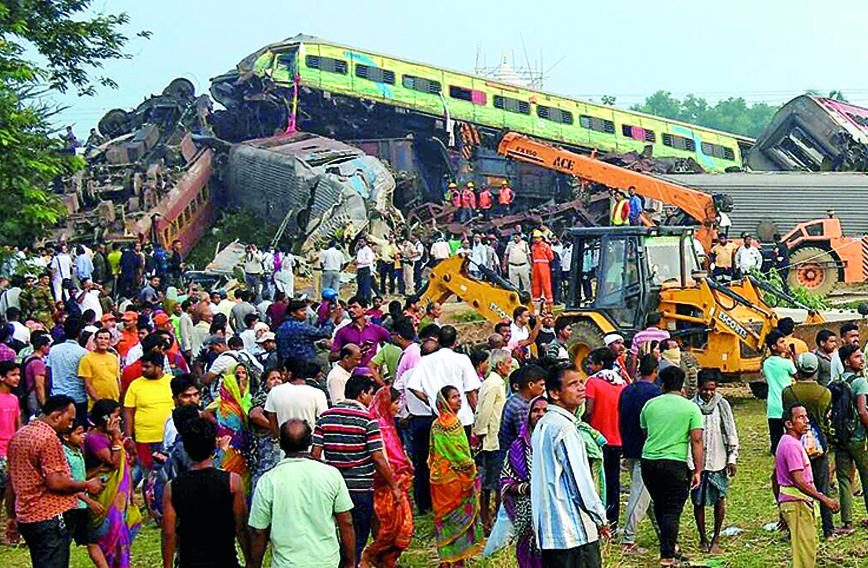
Railway budgets should spend much more on safety
Adding up accidents gives true picture of rail safety
Bharat Dogra
THE recent horrible train accident in Odisha is a grim reminder of the urgency of improving the safety of our trains. While all European Union countries combined recorded 683 deaths from railway accidents in 2021, India recorded 24 times this number with a figure of 16,431 deaths in 2021.
The year 2021 witnessed lower than average accidents as traffic was just recovering from the shutdown due to the pandemic the previous year. In a more normal year, judging from average figures for the past decade, about 24,000 people die in railway accidents every year in India, according to official data.
The number of injured persons has generally been very low, at just one injured per 10 railway accidents. In 2021 there were only about 1,800 injured people for about 18,000 accidents.
How can 10 railway accidents together result in only one injured person? In the case of the European Union the number of ‘seriously injured’ is more or less the same while in the US the recorded number of injured is much higher.
Following similar trends, the number of injured is likely to be several times more than what has been recorded in official data in India. In the case of road accidents too, the number of injured has been highly underestimated in official data.
The data for railway crossing accidents shows that in 2021 there were 1,505 railway accidents in which 1,807 people died and 148 were injured. Here, again, it is clear that the actual number of injured would be substantially higher.
In addition, reliable estimates are needed for accidents taking place on railway platforms. In large railway stations, big crowds on platforms often result in people being injured, particularly on staircases.
One high-risk situation often occurs when the platform for a departing train is changed just before departure time, leading to a huge surge of people — with the probability of stampedes increasing significantly.
On the other hand, some of the smallest stations which might be underequipped in terms of facilities have their own problems and sometimes, particularly at night, it becomes risky to either board or alight from a train, as trains stop for very short durations. It is really difficult to board or alight with luggage, which sometimes results in passengers being injured. Even minor assistance can help to protect several passengers, particularly the elderly.
Nearly two-thirds of deaths due to railway accidents result from falls and people getting run over. One can understand that most of these people come from very poor backgrounds. On the Mumbai Metropolitan Area train tracks there were 2,507 deaths and 2,155 injuries in 2022, according to official data. About 1,100 deaths were caused while crossing the railway tracks and about 700 were due to falls from running trains. Such victims are mostly from economically weaker sections.
A great human tragedy occurred in 2020 when, due to the Covid pandemic, very few passenger trains were running — nearly 8,700 poor people died while walking along rail tracks. They were mostly migrant workers and their families, including children, walking back to their homes in distant villages, whose reflexes had probably been slowed by hunger, thirst and fatigue.
However, this official data might be underestimated as the number of injured was only one-tenth of fatalities.
Injuries from railway accidents can be quite severe. Clearly, there is an urgent need to accord more attention to free treatment and rehabilitation of all injured, apart from providing financial compensation.
Railway budgets should have much more provision for safety and for taking care of the needs of ordinary passengers as many accidents result from overcrowding of trains. Budgets should increase provisions for safety aspects including proper maintenance of railway tracks. Those regions which report high accident rates should be monitored and special steps should be taken to improve safety.
The maximum number of railway accidents — about 19 percent of the all-India figure — is reported from Maharashtra while the most railway crossing accidents take place in Uttar Pradesh.
In Mumbai, a number of suggestions have been implemented to prevent deaths resulting from hurried crossing of railway tracks and these have resulted in some reduction, but the wider challenge here is of shortage of trains — resulting in overcrowding and a rush to board a particular train.
Trains used more by migrant workers have seen frequent overcrowding, particularly during the seasonal rush, and these deserve special attention.
Generally, there is a huge surge of sympathy in the immediate aftermath of major accidents, but afterwards, the long-term needs of medical care and rehabilitation are neglected. The railway authorities should pay more attention to making the railways safer and setting up a system of emergency healthcare.
Bharat Dogra is Honorary Convener, Campaign to Save Earth Now. His recent books include ‘Man over Machine’ and ‘A Day in 2071’.
Comments
Currently there are no Comments. Be first to write a comment!



